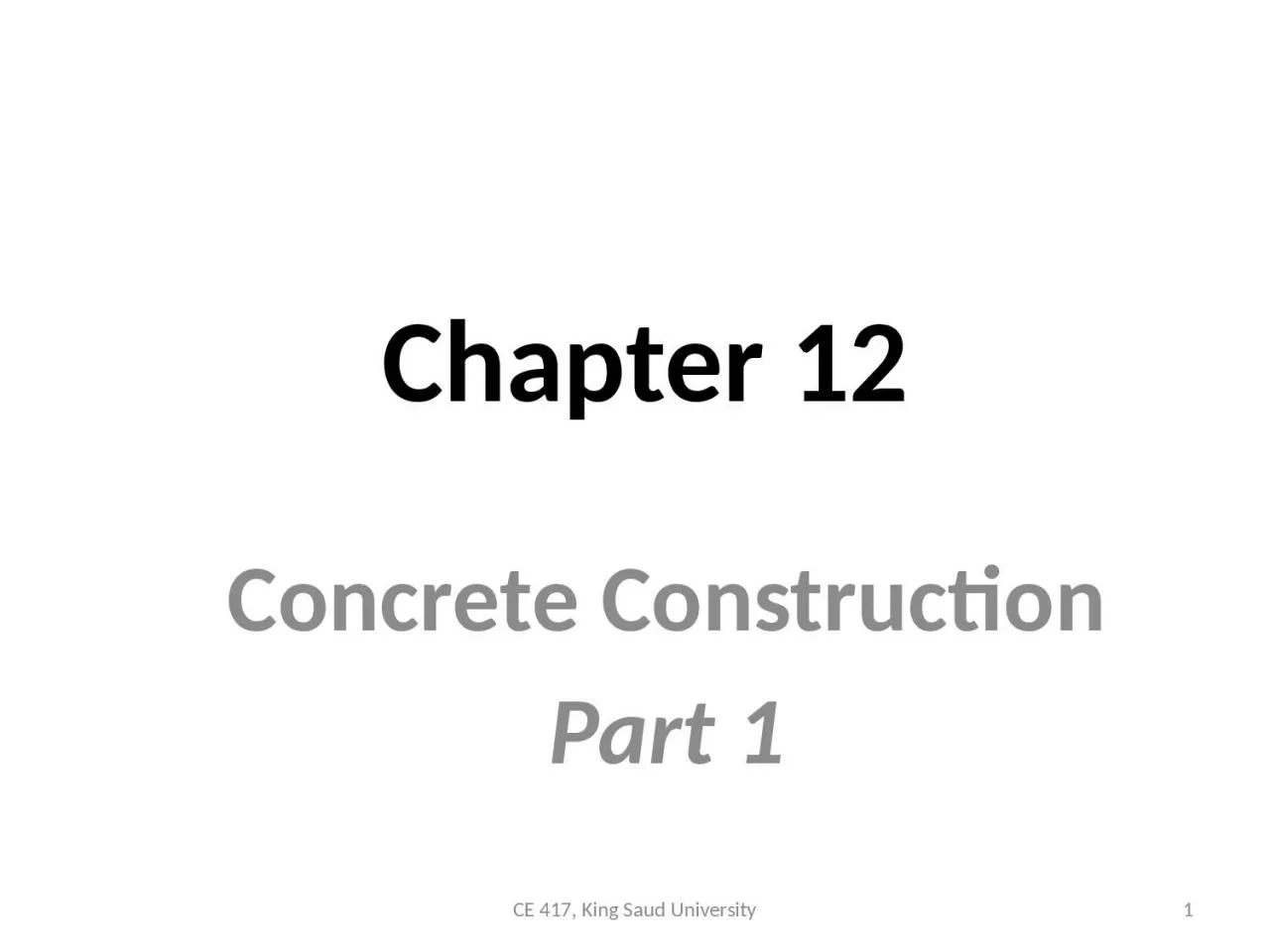

Part 1 1 CE 417 King Saud University Chapter 12 Concrete Construction 121 CONSTRUCTION APPLICATIONS OF CONCRETE 122 CONCRETE CONSTRUCTION PRACTICES 123 CONCRETE FORMWORK 124 REINFORCING STEEL ID: 1020173
Download Presentation The PPT/PDF document "Chapter 12 Concrete Construction" is the property of its rightful owner. Permission is granted to download and print the materials on this web site for personal, non-commercial use only, and to display it on your personal computer provided you do not modify the materials and that you retain all copyright notices contained in the materials. By downloading content from our website, you accept the terms of this agreement.
1. Chapter 12Concrete ConstructionPart 11CE 417, King Saud University
2. Chapter 12: Concrete Construction12-1 CONSTRUCTION APPLICATIONS OF CONCRETE12-2 CONCRETE CONSTRUCTION PRACTICES12-3 CONCRETE FORMWORK12-4 REINFORCING STEEL12-5 QUALITY CONTROL2CE 417, King Saud University
3. 12-1 CONSTRUCTION APPLICATIONS OF CONCRETEConcrete, or more properly portland cement concrete, is one of the world's most versatile and widely used construction materials. construction applications:paving of highways and airfields. its use in foundations for small structures, through structural components such as beams, columns, and wall panels, to massive concrete dams.all concrete used for structural purposes contains reinforcing steel embedded in the concrete to increase the concrete member's tensile strength. (Reinforced Concrete) 3CE 417, King Saud University
4. 12-1 CONSTRUCTION APPLICATIONS OF CONCRETEThe objective of the construction manager should be to develop a construction plan which minimizes construction costs while meeting all safety and quality requirements. Major elements of a concrete construction cost analysis include:Formwork costs including labor, equipment, and materials. Cost of reinforcing steel and its placement. Concrete materials, equipment, and labor for placing, curing, and finishing the concrete.4CE 417, King Saud University
5. FIGURE 12-1: Typical distribution of concrete construction costs.5CE 417, King Saud University
6. 12-1 CONSTRUCTION APPLICATIONS OF CONCRETE1. Cast-in-Place Concrete2. Precast Concrete3. Prestressed Concrete4. Architectural Concrete6CE 417, King Saud University
7. 1. Cast-in-Place ConcreteConcrete structural members have traditionally been built in-place by placing the plastic concrete into forms and allowing it to harden. The forms are removed after the concrete has developed sufficient strength to support its own weight and the weight of any construction loads. 7CE 417, King Saud University
8. FIGURE 12-2: Typical cast-in-place column and wall shapes.8CE 417, King Saud University
9. FIGURE 12-3: Pumping concrete into bottom of column form. (Courtesy of Gates & Sons, Inc.)9CE 417, King Saud University
10. FIGURE 12-4: Floor slab construction. (Courtesy of Concrete Reinforcing Steel Institute)10CE 417, King Saud University
11. FIGURE 12-5: Waffle slab. (Courtesy of Concrete Reinforcing Steel Institute)11CE 417, King Saud University
12. FIGURE 12-6: Flat slab and flat plate slab. (Courtesy of Concrete Reinforcing Steel Institute)12CE 417, King Saud University
13. 2. Precast ConcretePrecast concrete is concrete that has been cast into the desired shape prior to placement in a structure. There are a number of advantages obtained by removing the concrete forming, placing, finishing, and curing operations from the construction environment. Pre-casting operations usually take place in a central plant where industrial production techniques may be used. Since standard shapes are commonly used, the repetitive use of formwork permits forms to be of high quality at a low cost per unit.13CE 417, King Saud University
14. Precast ConcreteThere are a number of standard shapes commonly used for precast concrete structural members.Figure 12-7 illustrates some common beam and girder sections.Figure 12-8 illustrates Precast roof and floor panels.14CE 417, King Saud University
15. FIGURE 12-7: Precast beam and girder shapes.15CE 417, King Saud University
16. FIGURE 12-8: Precast slab shapes.16CE 417, King Saud University
17. FIGURE 12-9: Steps in tilt-up construction. (Courtesy of The Burke Company)17CE 417, King Saud University
18. FIGURE 12-9: Steps in tilt-up construction. (Courtesy of The Burke Company)18CE 417, King Saud University
19. 3. Prestressed ConcretePrestressed concrete is concrete to which an initial compression load has been applied. Prestressing serves to increase the load that a beam or other flexural member can carry before allowable tensile stresses are reached. because the concrete is quite strong in compression but weak in tension,19CE 417, King Saud University
20. FIGURE 12-10: Stresses in a Prestressed simple beam.20CE 417, King Saud University
21. Prestressed ConcreteAdvantages:permits a smaller, lighter member to be used in supporting a given load. reduces the amount of deflection in a beam. Since the member is always kept under compression, any cracking that does occur will remain closed up and not be apparent. 21CE 417, King Saud University
22. Prestressed ConcreteDisadvantages:higher material, equipment, and labor cost involved in the production of prestressed components. 22CE 417, King Saud University
23. Prestressed ConcreteThere are two methods for producing prestress in concrete members; pretensioning and posttensioning. 23CE 417, King Saud University
24. Prestressed ConcreteCaution must be observed in handling and transporting pretensioned prestressed members, particularly if they are asymmetrically stressed.24CE 417, King Saud UniversityFIGURE 12-11: Lifting prestressed beam at the center.It should be lifted by the ends or by using multiple lift points along the beam.
25. 4. Architectural ConcreteThe architectural use of concrete to provide appearance effects has greatly increased in recent years. Architectural effects are achieved by the shape, size, texture, and color used. 25CE 417, King Saud University
26. FIGURE 12-12: Application of architectural concrete. (Courtesy of Portland Cement Association)26CE 417, King Saud University
27. Architectural ConcreteSome of the major methods used for obtaining architectural concrete effects include: exposed aggregate surfaces (Figure 12-13a), special surface designs and textures achieved by the use of form liners (Figure 12-13b), and mechanically produced surfaces (Figure 12-14). Exposed aggregate surfaces are produced by removing the cement paste from the exterior surface, exposing the underlying aggregate. 27CE 417, King Saud University
28. FIGURE 12-13: Architectural concrete surfaces. (Courtesy of Portland Cement Association)28CE 417, King Saud University
29. FIGURE 12-14: Mechanically produced concrete surface texture. (Courtesy of Portland Cement Association)29CE 417, King Saud University